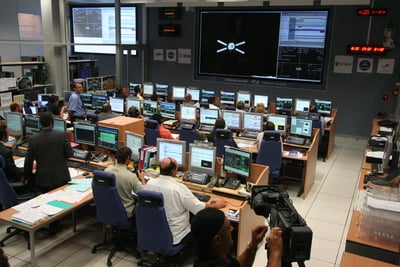[/caption] Europe's most advanced robotic spaceship, the Automated Transfer Vehicle (ATV), has effectively ended its 6-month mission to the International Space Station (ISS). It successfully undocked today (Friday) at 21:29 GMT to begin its slow 3 week journey toward the Earth's atmosphere where it is set for re-entry on September 29th. This was the first ever ATV to be launched and was named after the 19th Century novelist, Jules Verne; another four ATVs are scheduled for construction. Jules Verne's re-entry is set for night time over an uninhabited region of the Pacific Ocean and NASA will use this opportunity to monitor the fireball so the characteristics of re-entering spacecraft can be studied...
It might seem like a waste - after all, the ATV cost 1.3 billion euros or 1.9 billion dollars to build - but Jules Verne was designed to be a single-use, disposable resupply ship for the space station. However, its duties as a supply ship weren't restricted to grocery deliveries. After it was
launched in March
, the ATV underwent a series of tests in space to prepare it for arrival at the station on April 3rd. When attached to the station, the
ATV surpassed all expectations
and performed many tasks that hadn't been considered by mission control. Although the ATV provided a
valuable re-boost option
for the station (four times in total), it also provided the thrust to slow the ISS down to
avoid a chunk of satellite debris in August
. The ship was also a welcome retreat for the crew of the station, giving them a roomy volume for recreation and cleaning chores. I think Jules Verne will be sorely missed.
So, like the Russian Progress 29 resupply ship that was
dropped from the station on Wednesday
, Jules Verne was packed up with several tonnes of trash and unwanted equipment from the ISS and jettisoned into space.
The ATV will now use its remaining fuel to park its 13.5 tonne mass in a new orbit for the following three weeks before it is commanded to drop from orbit and begin re-entry. Jules Verne's fiery suicide will happen at night so scientists can gain an insight into how large objects behave when they burn up in the Earth's atmosphere. To monitor the event, NASA will deploy two aircraft with radar, UV and other sensors to track the incoming ATV.
" ," - Herve Come, ESA's ATV lead mission director.
Sources:
ESA
, AFP
 Universe Today
Universe Today
